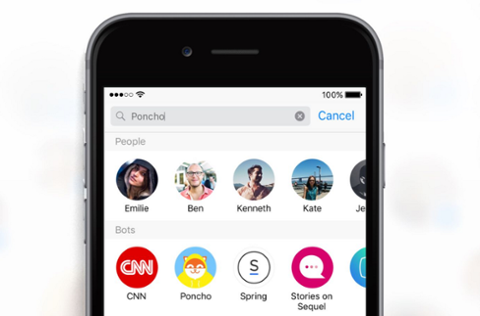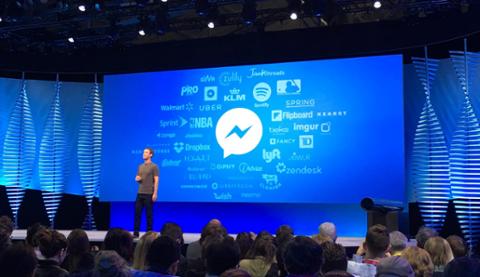
Bots seem to be popping up just about everywhere. Having surged into the public consciousness with their inclusion in
Facebook Messenger, bots can also be found in Slack, Kik and non U.S.-based platforms such as WeChat. Handy for simpler interactions, they may also be the next major content distribution network. The concept of bots is simple: instead of downloading a series of disparate apps, you have a
structured conversation with a service inside an app you already have and (hopefully) use. In that way, apps such as Messenger serve as Trojan Horses for other services. It’s about control, too. If you’re already chatting with friends in Facebook Messenger, companies want you to think that buying goods, getting news or simply asking about the weather might be easier with a bot. Bots are also about delivering content, and their ease of use has rendered them prime digital real estate for developers. As Jeff Lawson, CEO of Twilio, put it: “Messaging is a great medium for content distribution because of the personal one-on-one nature of the channel. “A great example of this is what
The New York Times built during the Olympics,” Lawson added. “Users could subscribe to
The New York Times Olympics app and receive daily updates on the games – not from
The New York Times, but from Sam at the news desk at
The New York Times.
The New York Times was able to create a personalized experience for its readers, largely due to the medium they selected - text messaging.”
Bots Beyond Information
Aside from delivering simple news stories, bots are also being used to sell consumable goods. At its F8 conference this year, Facebook showed off several retailers that leveraged bots to help users become customers by simply returning information to an algorithm; you tell the bot what size and color of shirt you want, and it tells you what’s available. After you select a shirt (or other good), the bot arranges payment and delivery. In one fell swoop, you’ve gone from a passive shopper to an active buyer, in large part because the bot is an always-on customer service rep that has intimate knowledge of what’s in stock. It’s still
very early days for bots, but the concept is solid and the reasoning sound. In addition to being dead simple to use (you’re just having a conversation), bots are also easy to find and download within apps like Facebook Messenger; a tap on the search bar brings up the most popular bots, and entering search criteria (like ‘sports’) tells you which bots may suit you best. Already popular, bots are poised to explode stateside. Though Apple opened up iMessage to apps with the release of iOS 10, it’s limited the scope of commerce apps to discovery. You can share your new favorite shoes with a friend, but you’ll have to click on a redirect link to actually complete a purchase. Expect the bot landscape to get much more competitive in coming years. Facebook Messenger is now set up to
accept payments for stuff you want to buy, and there’s no reason to think Apple wouldn’t follow suit with an Apple Pay integration for iMessage apps (or a method to make conversational transactions available to iMessage apps).
Bloomberg calls WeChat “the app that runs China’s economy,” and with good reason; you can buy or request just about any good or service you might want via the app. Other parts of the world are just starting to realize how intuitive and lucrative a bot platform can be, so expect explosive growth over the next few years.
 Bots seem to be popping up just about everywhere. Having surged into the public consciousness with their inclusion in Facebook Messenger, bots can also be found in Slack, Kik and non U.S.-based platforms such as WeChat. Handy for simpler interactions, they may also be the next major content distribution network. The concept of bots is simple: instead of downloading a series of disparate apps, you have a structured conversation with a service inside an app you already have and (hopefully) use. In that way, apps such as Messenger serve as Trojan Horses for other services. It’s about control, too. If you’re already chatting with friends in Facebook Messenger, companies want you to think that buying goods, getting news or simply asking about the weather might be easier with a bot. Bots are also about delivering content, and their ease of use has rendered them prime digital real estate for developers. As Jeff Lawson, CEO of Twilio, put it: “Messaging is a great medium for content distribution because of the personal one-on-one nature of the channel. “A great example of this is what The New York Times built during the Olympics,” Lawson added. “Users could subscribe to The New York Times Olympics app and receive daily updates on the games – not from The New York Times, but from Sam at the news desk at The New York Times. The New York Times was able to create a personalized experience for its readers, largely due to the medium they selected - text messaging.”
Bots seem to be popping up just about everywhere. Having surged into the public consciousness with their inclusion in Facebook Messenger, bots can also be found in Slack, Kik and non U.S.-based platforms such as WeChat. Handy for simpler interactions, they may also be the next major content distribution network. The concept of bots is simple: instead of downloading a series of disparate apps, you have a structured conversation with a service inside an app you already have and (hopefully) use. In that way, apps such as Messenger serve as Trojan Horses for other services. It’s about control, too. If you’re already chatting with friends in Facebook Messenger, companies want you to think that buying goods, getting news or simply asking about the weather might be easier with a bot. Bots are also about delivering content, and their ease of use has rendered them prime digital real estate for developers. As Jeff Lawson, CEO of Twilio, put it: “Messaging is a great medium for content distribution because of the personal one-on-one nature of the channel. “A great example of this is what The New York Times built during the Olympics,” Lawson added. “Users could subscribe to The New York Times Olympics app and receive daily updates on the games – not from The New York Times, but from Sam at the news desk at The New York Times. The New York Times was able to create a personalized experience for its readers, largely due to the medium they selected - text messaging.”
 Bots seem to be popping up just about everywhere. Having surged into the public consciousness with their inclusion in Facebook Messenger, bots can also be found in Slack, Kik and non U.S.-based platforms such as WeChat. Handy for simpler interactions, they may also be the next major content distribution network. The concept of bots is simple: instead of downloading a series of disparate apps, you have a structured conversation with a service inside an app you already have and (hopefully) use. In that way, apps such as Messenger serve as Trojan Horses for other services. It’s about control, too. If you’re already chatting with friends in Facebook Messenger, companies want you to think that buying goods, getting news or simply asking about the weather might be easier with a bot. Bots are also about delivering content, and their ease of use has rendered them prime digital real estate for developers. As Jeff Lawson, CEO of Twilio, put it: “Messaging is a great medium for content distribution because of the personal one-on-one nature of the channel. “A great example of this is what The New York Times built during the Olympics,” Lawson added. “Users could subscribe to The New York Times Olympics app and receive daily updates on the games – not from The New York Times, but from Sam at the news desk at The New York Times. The New York Times was able to create a personalized experience for its readers, largely due to the medium they selected - text messaging.”
Bots seem to be popping up just about everywhere. Having surged into the public consciousness with their inclusion in Facebook Messenger, bots can also be found in Slack, Kik and non U.S.-based platforms such as WeChat. Handy for simpler interactions, they may also be the next major content distribution network. The concept of bots is simple: instead of downloading a series of disparate apps, you have a structured conversation with a service inside an app you already have and (hopefully) use. In that way, apps such as Messenger serve as Trojan Horses for other services. It’s about control, too. If you’re already chatting with friends in Facebook Messenger, companies want you to think that buying goods, getting news or simply asking about the weather might be easier with a bot. Bots are also about delivering content, and their ease of use has rendered them prime digital real estate for developers. As Jeff Lawson, CEO of Twilio, put it: “Messaging is a great medium for content distribution because of the personal one-on-one nature of the channel. “A great example of this is what The New York Times built during the Olympics,” Lawson added. “Users could subscribe to The New York Times Olympics app and receive daily updates on the games – not from The New York Times, but from Sam at the news desk at The New York Times. The New York Times was able to create a personalized experience for its readers, largely due to the medium they selected - text messaging.”



